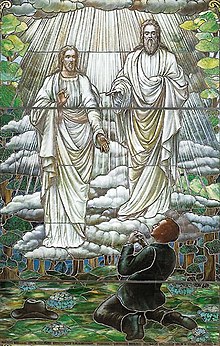
Back المورمونية والمسيحية Arabic Mormonismo asin Kristiyanismo BCL Mormonismo kaj kristanismo Esperanto Mormonismo e kristanismo IO 摩爾門教與基督教 Chinese Mormonism and Nicene Christianity Zulu

Mormonism and Nicene Christianity (often called mainstream Christianity)[1] have a complex theological, historical, and sociological relationship. Mormons express their doctrines using biblical terminology. They have similar views about the nature of Jesus Christ's atonement, bodily resurrection, and Second Coming as mainstream Christians. Nevertheless, most Mormons do not accept the doctrine of the Trinity as codified in the Nicene Creed of 325 and the Nicene-Constantinopolitan Creed of 381.[2] Although Mormons consider the Protestant Bible to be holy scripture, they do not believe in biblical inerrancy. They have also adopted additional scriptures that they believe to have been divinely revealed to Joseph Smith,[3][4][5] including the Book of Mormon,[3][4][5] the Doctrine and Covenants,[3] and the Pearl of Great Price.[3] Mormons practice baptism and celebrate the sacrament of the Lord's Supper, but they also participate in other religious rituals. Mormons self-identify as Christians.[6]
Focusing on differences, some Christians consider Mormonism non-Christian; others, focusing on similarities, consider it to be a Christian religion.[7][8] Opinions differ among scholars of religion on whether to categorize Mormonism as a separate branch of Christianity or as the "fourth Abrahamic religion" (alongside Judaism, Christianity and Islam).[3][9] Mormons do not accept non-Mormon baptism and most non-Mormon Christians do not accept Mormon baptism. Mormons regularly proselytize individuals actually or nominally within the Christian tradition, and some traditional Christians, especially evangelicals, proselytize Mormons. Some view Mormonism as a form of Christianity, but distinct enough from traditional Christianity so as to form a new religious tradition, much as Christianity is more than just a sect of Judaism.[10]
The early Mormonism that originated with Joseph Smith in the 1820s shared strong similarities with some elements of 19th-century American Protestantism.[3][4][11] Mormons believe that God, through Smith and his successors, restored various doctrines and practices that were lost from the original Christianity taught by Jesus Christ.[12] For example, Smith, as a result of his "First Vision", primarily rejected the Nicene doctrine of the Trinity and instead taught that God the Father, his son Jesus Christ, and the Holy Ghost are three distinct "personages".[13][14][15] While the largest Mormon denomination, The Church of Jesus Christ of Latter-day Saints (LDS Church), acknowledges its differences with mainstream Christianity, it also focuses on its commonalities such as its focus on faith in Christ, following the teachings of Jesus Christ, the miracle of the atonement, and many other doctrines.[16]
- ^ Prakashan, Jnanada (2009). World Encyclopaedia of Interfaith Studies: Global interfaith movement. p. 733.
- ^ Shipps (1985, pp. 148–49) (arguing that "Mormonism differs from traditional Christianity in much the same fashion that traditional Christianity ... came to differ from Judaism.").
- ^ a b c d e f Mason, Patrick Q. (3 September 2015). "Mormonism". Oxford Research Encyclopedia of Religion. Oxford: Oxford University Press. doi:10.1093/acrefore/9780199340378.013.75. ISBN 978-0-19-934037-8. Archived from the original on 30 November 2018. Retrieved 15 May 2021.
- ^ a b c Givens, Terryl L. (2003) [2002]. ""A Seer Shall the Lord My God Raise Up": The Prophet and the Plates". By the Hand of Mormon: The American Scripture that Launched a New World Religion. New York: Oxford University Press. pp. 8–42. doi:10.1093/019513818X.003.0002. ISBN 978-0-19-513818-4. OCLC 1028168787.
- ^ a b Noll, Mark A. (2002). "The High Tide of Protestantism, 1830-1865". The Old Religion in a New World: The History of North American Christianity. Grand Rapids, Michigan and Cambridge, UK: Wm. B. Eerdmans. pp. 102–103. ISBN 978-0-8028-4948-9. LCCN 2001040537.
- ^ Mormons in America: Certain in Their Beliefs, Uncertain of Their Place in Society Archived September 24, 2015, at the Wayback Machine, Pew Forum on Religion & Public Life 2012, p.10: Mormons are nearly unanimous in describing Mormonism as a Christian religion, with 97% expressing this point of view
- ^ Rosentiel, Tom (4 December 2007). "Public Opinion About Mormons". Pew Research Center. Retrieved 7 May 2021.
- ^ Stark & Neilson (2005, p. 14).
- ^ Shipps, Jan (2001). "Is Mormonism Christian? Reflections on a Complicated Question". In Eliason, Eric A. (ed.). Mormons and Mormonism: An Introduction to an American World Religion. Urbana and Chicago: University of Illinois Press. pp. 76–98. ISBN 0-252-02609-8. S2CID 142892455.
- ^ Shipps (2000, p. 338).
- ^ Turner, John G. (2016). The Mormon Jesus: A Biography. Cambridge, Massachusetts and London: Belknap Press of Harvard University Press. p. 5. ISBN 978-0-674-73743-3..
- ^ Hughes, Richard T. (2001). "Soaring with the Gods: Early Mormons and the Eclipse of Religious Pluralism". In Eliason, Eric A. (ed.). Mormons and Mormonism: An Introduction to an American World Religion. Urbana and Chicago: University of Illinois Press. pp. 23–46. ISBN 0-252-02609-8. S2CID 142892455.
- ^ Davies (2003, Divine–human transformations, pp. 65–90)
- ^ Dahl, Paul E. (1992), "Godhead", in Ludlow, Daniel H. (ed.), Encyclopedia of Mormonism, New York: Macmillan Publishing, pp. 552–553, ISBN 0-02-879602-0, OCLC 24502140, retrieved 7 May 2021 – via Harold B. Lee Library
- ^ Smith, Joseph Fielding (1956). Doctrines of Salvation. Bookcraft. p. 1:38.
- ^ See, commentary, "Real Differences, Real Similarities and Biblical Christianity". Mormon News Room. October 11, 2007.
© MMXXIII Rich X Search. We shall prevail. All rights reserved. Rich X Search